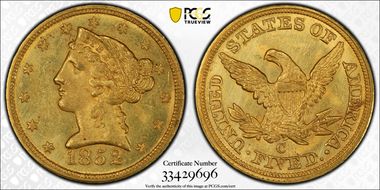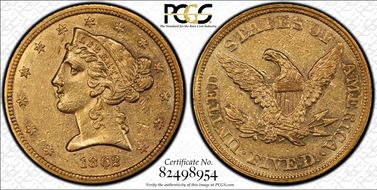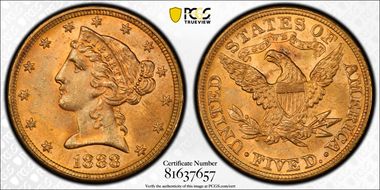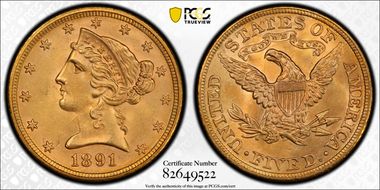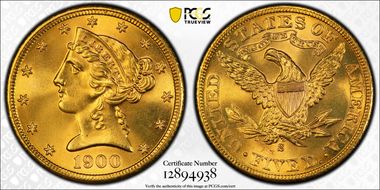Jim Dixon 的钱币相册
This coin is highly reflective with satiny, semi-prooflike luster. The strike is extremely strong with the exception of some of the stars. The color is yellow-gold. Purchased from Doug Winter.
HW Bass Jr Coll Pedigree. Winter Variety 1. The strike on this coin is absolutely amazing. There is no weakness on the stars, portrait or the reverse. The luster is semi-prooflike and the color is a deep yellow gold. There are minimal abrasions for the grade. CAC.
HW Bass Jr Coll Pedigree. Winter Variety 1. The strike on this coin is absolutely amazing. There is no weakness on the stars, portrait or the reverse. The luster is semi-prooflike and the color is a deep yellow gold. There are minimal abrasions for the grade. CAC.
Winter Variety 7-E. This MS62 example is tied with a number of other pieces at both services for second place in the Condition Census. The green-gold surfaces are lustrous and reflective, with scattered light marks and a nice, original appearance. The strike is very sharp for a ’42-D Small Date. CAC.
Bass Pedigree. Winter Variety 1, Die State II. This example has rich frost luster beneath light golden-orange color. The strike is very sharp for this year/mint. There is a discernible reverse die crack from the rim near the first letter A in America through the wing to the eagle's neck. Purchased from Doug Winter. CAC.
There are some interesting raised die lines at a number of obverse locations including Liberty's eye, nose, mouth and throat. The reverse shows indications of die rust in the fields. Shimmering, unbroken icy-velvet mint bloom complements a reasonably strong strike. The color is a light orange-gold. CAC.
The Large Date variety is more frequently seen than the Small Date, but neither variety is plentiful in Mint State grades. This piece exhibits lovely frosty cartwheel luster with die polish lines clearly visible on both the obverse and reverse. The strike is strong except for the eagle’s wing tips which appear very flat. There is a small planchet flaw below Liberty’s bun, just to the right of her neck. The reverse die is rotated slightly clockwise. The color is a yellow/orange gold. CAC.
Winter Variety 1. The strike on this example is generally strong, but there is weakness in the curls around the face on the obverse and on the arrow feathers on the reverse. The luster is frosty and the color is yellow gold with green-gold highlights. The reverse is rotated slightly clockwise. Purchased from Doug Winter. CAC.
Winter Variety 1, Die State II. This crisply struck piece is nearly devoid of planchet flaws, and Liberty's cheek in particular is beautifully preserved. A few moderate marks in the obverse field are typical for the grade. The radial die crack is present from the left edge of the U in UNITED, and is the usual die state of the variety. Purchased from New York Gold Mart. CAC.
Bass Pedigree. Winter Variety 2 (Early Die State). This example has frosty texture with rich green gold color. The strike on both the obverse and reverse are sharp. Although not clearly visible in the image, there are interesting reverse clash marks between the eagle's beak and left (facing) wing and below each wing. Ex: Bowers and Merena 5/00: 427 (Bass III); DiBello 5/70: 882.
Typical of most half eagles minted in Philadelphia, the strike on this coin is very strong. The color is a rich orange-gold. The luster has a bold cartwheel effect, but is somewhat unusual. In most cases, the luster is a rich frost, but in others such as the upper left and lower left obverse fields, the texture is decidedly grainy. The graininess is also evident on the reverse in the planchet flaw (?) above the eagles head.
Winter Variety 1. This is the finest of four ’52-C coins sold at auction in December, 2007 by Gulfcoast Coins in Florida. This was the second small “hoard” of ’52-C half eagles that came to market in the last 20 years. Consistent with most ‘52-Cs, the current example exhibits strike weakness in the centers of both the obverse and reverse. Die polish lines are visible on both the obverse and reverse. The luster is semi-prooflike with a great deal of reflectivity. The color is green-gold. The reverse die is rotated slightly counter-clockwise. Purchased from Bob Harwell. CAC.
A flashy Philadelphia mint coin with swirling frost luster more resembling a coin from the 1880's than one from the 1850's. The rich rose gold surfaces exhibit a characteristically strong Philadelphia mint strike. Purchased from Numismatic Assets. CAC.
The current example exhibits frosty luster that is rich and pillowy. The underlying color is orange-gold but the coin is highlighted with an attractive “red copper” patina. The strike is somewhat atypical for a Philadelphia issue in that there is some strike weakness on the obverse curls and the reverse arrow feathers. The reverse is rotated slightly clockwise. CAC.
MPD-001. Breen-6614. A misplaced date variety, the top of a 1 peers from the denticles between the 18 in the date. On the obverse, there is a die clash in front of Liberty’s mouth, neck and to the right of the lower part of her bun; on the reverse clashes are seen between the eagle’s beak and her right wing and below both wings. The obverse has a pillowy satin luster and the reverse has frosty luster. The color is a pleasing untoned light orange-gold.
Winter Variety 1. This piece displays strike details that are atypically strong for the issue, with Liberty's hair curls all pleasingly delineated and separated, and bold, sculptural details on both the eagle and the peripheries. The surfaces display the usual soft, satinlike mint luster. Lightly abraded surfaces lack the numerous deep abrasions usually found on this issue. This example has attractive medium orange-gold hues. This is the finest known example of this date/mint. Purchased from Doug Winter. CAC.
This near-Gem has deeply incised detail with swirling, shimmery luster that is as much orange as yellow. The obverse is exceptional, while the reverse has some light chatter in the field above the eagle’s head. Carefully preserved and beautiful. Purchased from Doug Winter. CAC...Previously an NGC MS64+.
Elrod Pedigree. Winter Variety 1. The 1858-C is probably the best struck example of half eagles from Charlotte in the late 1850s. This coin is a perfect example of this with only minor weakness in the curls around the face. Die polish lines can be seen clearly on the reverse. The luster is frosty and the color is an attractive orange-gold with green highlights. There is a characteristic '58-C die lump on the cheek. The description for Heritage 1/07: 3555 included the following pedigree history --- This piece was at one time in Stanley Elrod's # 1 Collection. That group of coins was sold privately and was not included in the Paramount or Stack's auctions of Elrod's C-mint gold. Purchased from Doug Winter; ex: Heritage 1/07: 3555; ex: Elrod. CAC.
Winter Variety 1, Die State 1. Both the obverse and reverse have pleasing original green-gold color with the reverse having traces of orange-gold highlights. The design elements are essentially full, except for weakness on the reverse that is present on all 1859-C half eagles. It is believed that this weakness is due to an improperly hubbed die. The obverse has nearly vertical die polish lines that are visible under 5X magnification.
Blazing cartwheel luster emanates from this late no motto example. The strike is sharply detailed throughout and the texture is frosted. The obverse has very distinct die polish lines in evidence. The underlying color is a green gold which is covered by rich rose-gold toning. This variety of the 1860 half eagle has an interesting “punch” on the earlobe that again gives the appearance of an earring. Perhaps mint personnel were trying to dress up Miss Liberty. This is an absolutely beautiful example of an 1860's half eagle.
The Philadelphia 1861 half eagle accounts for nearly half of all No Motto $5 Liberty coins minted. As a result, it is the most available representative for a type set. The current example exhibits a strong strike and frosty cartwheel luster. The underlying color is orange-gold and the surfaces are highlighted with reddish overtones. CAC.
The 1862 has an original mintage of 4,430 of which 60-70 are known, mostly in the EF40 to AU50 range. This example is very lustrous with light wear which is limited to the high spots of the obverse. The fields show some scattered marks which is typical for this issue; the most noticeable are in the right obverse field. Die polish marks are clearly visible in the protected areas on the obverse, running from 11 to 5. The color is a nice natural rose and light yellow-gold and the strike is excellent. Purchased from Doug Winter.
This is truly a Gem for the grade with lovely rich natural medium orange-gold color and some contrasting dirt in the devices. A good deal of luster can be seen on both sides and the detail is above average for the issue. This coin is a great combination of rarity and eye appeal. Purchased from Doug Winter. CAC.
The 1864 is a scarce coin that is frustratingly difficult to find “nice”. This example has wonderful eye appeal largely because of the color; a green-gold base with beautiful orange and red toning. The luster is very apparent and the strike is strong for the issue. Purchased from New York Gold Mart.
An amazing crusty original with a blend of frost and semi-prooflike reflective surfaces. It has orange-gold and green colors with some deep coppery splashes as highlights. Purchased from Doug Winter. CAC.
Another crusty original Philadelphia mint coin from the mid-1860s. Nice frosty luster remains in the protected areas. The strike is good and the color is a beautiful green gold with orange/red highlights at the periphery. All abrasions are shallow with no major marks. This coin was previously graded AU58 by NGC. Purchased from Barry Stuppler. CAC.
The '67-S is unknown in uncirculated condition, and there are only six known in AU58, two in PCGS holders and four in NGC holders. Since no PCGS coins and only one NGC coin has been sold at auction, it is likely that this number includes resubmissions. This coin has a good strike, although there is weakness on the top of the hair, on the bun and on the claws and arrows. The luster is subdued satin on the obverse with rich frost on the reverse. There are no major abrasions on the coin. Is this the finest '67-S known? I think so. Purchased from New York Gold Mart. CAC.
Satiny cartwheel luster is complimented by beautiful reddish-orange color that greets the viewer from both sides. The surfaces are generally free of even minor abrasions. Softness of strike over the top of Liberty's portrait, the highpoints of the reverse eagle and some of the obverse stars is characteristic of virtually all examples of this issue. An absolutely stunning coin that is the finest known. Purchased from Doug Winter. CAC.
Satiny cartwheel luster is complimented by beautiful reddish-orange color that greets the viewer from both sides. The surfaces are generally free of even minor abrasions. Softness of strike over the top of Liberty's portrait, the highpoints of the reverse eagle and some of the obverse stars is characteristic of virtually all examples of this issue. An absolutely stunning coin that is the finest known. Purchased from Doug Winter. CAC.
Green-gold with a great deal of bright satin luster remaining. The strike is good except for some weakness in the centers of both the obverse and reverse. The contact marks are consistent with the grade. Purchased from Barry Stuppler.
There are fewer than 100 1871 half eagles extant and the highest graded coins are MS61. The current example is a crusty original coin that is orange-gold with deeper orange toning. The luster is a thick frost. The only contact mark of note is a "reverse L" on the back of Liberty's neck. A beautiful coin. Purchased from Doug Winter. CAC.
This is a frosty, cameo prooflike coin with absolutely amazing eye appeal. There is some weakness in the centers of both the obverse and reverse. The periphery is very well struck. The color is a rich orange gold. There are four grading events for MS64 (two at NGC, two at PCGS) with none finer. However, there are ten auction appearances for an MS64 1872 at Heritage between 1994 and 2003 in both PCGS and NGC holders and every one of these appearances is this coin. Is it possible that this is the lone MS64? Purchased from Doug Winter.
Winter Variety 1-B. A well struck example of the '75-CC. The obverse has more detail than the typical variety 1-B example but the reverse is a little soft with little detail on the horizontal lines of the shield. The texture is satiny and the color is a green gold with rose gold highlights, particularly in the recessed areas. Abrasions are light with no major distracting marks. Purchased from Paul Nugget. CAC.
Winter Variety 1-A. This example has an excellent strike and a raised die lump on the neck, a characteristic of all known ’76-CC half eagles. The luster is frosty and the color is a light rose gold. Purchased from Barry Stuppler; ex: Paul Nugget. CAC.
This is the second finest known ’77-S; only one MS64 surpasses this example (2/2015). This coin is very lustrous and has an attractive frosty cartwheel effect on both the obverse and reverse. The strike is very strong throughout and the color is a pleasing honey/light rose gold. It is extremely “clean” for the grade with no ticks on Miss Liberty’s portrait. CAC.
The strike on this coin is very strong. The cartwheel luster is frosty and is covered with rich orange-gold toning. The overall eye appeal of this piece is exceptional. Housed in an old green holder. Purchased from Barry Stuppler.
A lustrous and boldly struck half eagle that has sunset gold color. The obverse is very well preserved; one small mark is noted below the mintmark on the reverse. CAC.
A lustrous and boldly struck half eagle that has sunset gold color. The obverse is very well preserved; one small mark is noted below the mintmark on the reverse. CAC.
This is a sharply struck near-Gem with a frosty texture and excellent cartwheel luster. The color is a very attractive rose gold. CAC.
A lovely example of this date with a strong strike, orange/gold color and pleasing luster. Purchased from Barry Stuppler. CAC.
This coin has an excellent strike and beautiful cartwheel luster. It is honey gold in color. Purchased from Dave Weygant. CAC.
Semi-prooflike sheen radiates from the well preserved surfaces of this sharply struck near-Gem example. A few wispy marks limit the grade, but they are much too small to detract from the excellent eye appeal. CAC.
Blazing cartwheel luster emanates from this orange gold example. There is slight toning throughout which is a slightly richer orange. The surfaces are frosty and the strike is extremely strong. Purchased from CNR. Previously an NGC 66+.
The 1886 half eagle is a sleeper in the series. Although considered a fairly common date, there are only six coins graded higher than MS64. The current example is orange gold with light “tangerine” toning on soft satin surfaces. The strike is very strong and marks are minimal for the grade. Housed in an old green holder.
This is a lustrous coin with rich frosty luster. The strike is characteristically strong for a San Francisco issue. The underlying color is a green gold which is highlighted by beautiful orange gold toning. The eye appeal is excellent. Purchased from Certified Assets. CAC.
An extremely important Choice Mint State specimen, surviving from a small mintage of only 18,201 business strikes. This example exhibits frosty orange-gold luster with splashes of pale toning on each side. The surfaces host a few scattered marks that limit the grade.
Well struck with beautiful satiny mint surfaces exhibiting full mint bloom. Three small reeding marks on the cheek and light friction in the left obverse field are the only issues limiting the grade of this very attractive coin. The 1890 Philadelphia is a very rare coin in high grade. Purchased from Doug Winter. CAC...Plate Coin for with motto half eagles in CoinFacts
The 1891 is a low mintage issue, and is scarce in MS64 with none graded finer at PCGS. This is a well struck and highly lustrous representative with clean surfaces aside from moderate marks near stars 1 and 3. Die clashes are evident by Liberty’s throat and below the eagle’s beak. Subdued satin luster is present on the obverse and booming frosty cartwheel luster emanates from the reverse. The color is orange-gold with olive highlights on the obverse and rich rose gold toning on the reverse. CAC.
The 1893 is conditionally rare in MS66 and there are only one or two coins graded finer in MS68 (are the NGC and PCGS 68s really the same coin?). The current coin exhibits subdued frosty luster throughout. The strike is exceptionally strong with die clashes evident at Liberty’s throat and below the eagle’s beak. Coppery gold surfaces show prominent orange overtones through much of the fields. CAC...Previously an NGC 66+.
The 1894 is a fairly common date but is scarce in gem; there are only three coins graded higher; two 66 and one 67 at PCGS (2/2015). This date does not generally “come nice”. This is the third MS65 that I’ve owned, trying to find an example with acceptable luster for the grade. The current example has a muted satin luster and is sunset gold in color. As with most Philadelphia issues from this era, the strike is strong. CAC.
The 1895 is sometimes available in Gem, but is rare in higher grades. There are only eleven grading “events” in MS66 with three finer in MS67. The current example is a very well struck coin with rich frosty luster. The color is orange gold. Purchased from Barry Stuppler; ex: Legend Numismatics. CAC.
The 1895 is sometimes available in Gem, but is rare in higher grades. There are only eleven grading “events” in MS66 with three finer in MS67. The current example is a very well struck coin with rich frosty luster. The color is orange gold. Purchased from Barry Stuppler; ex: Legend Numismatics. CAC.
This example has a sharp strike and pleasing cartwheel luster. The orange gold toning gives the coin excellent eye appeal. Purchased from Bozarth Numismatics.
The yellow-gold surfaces offer very nice cartwheel luster and pale olive highlights. The strike is bold. CAC.
I replaced the 1899 MS67 coin in my collection with this example because of its exceptional eye appeal. The rich frosted surfaces have a shimmering cartwheel luster. The color is a rich yellow and green-gold and the shrike is very sharp throughout. The surfaces are virtually pristine aside from a couple of minor marks above Liberty's brow. CAC.
In 1900, the San Francisco Mint struck only 329,000 pieces. Many were lost to attrition, and Garrett and Guth suggest that the issue "... is probably 10 times rarer than the 1900 Philadelphia issue." The current coin has a phenomenal strike and blazing frosty cartwheel luster. The color is a rich orange gold. Note: The haze by the reverse shield is on the holder, not the coin.
In 1900, the San Francisco Mint struck only 329,000 pieces. Many were lost to attrition, and Garrett and Guth suggest that the issue "... is probably 10 times rarer than the 1900 Philadelphia issue." The current coin has a phenomenal strike and blazing frosty cartwheel luster. The color is a rich orange gold. Note: The haze by the reverse shield is on the holder, not the coin.
This Plus-graded Premium Gem displays frosty, green-gold mint luster, with well-defined devices and excellent surface preservation. CAC.
An exceptionally appealing Gem with deep peach-gold color and satin surfaces remarkably free of contact for the grade. The strike is very strong and the cartwheel effect is complete. CAC.
This Premium Gem is highly lustrous with satin surfaces, brilliant sunset-gold color, and bold design features. The mintage of 392,000 suggests an issue that is available in all grades. However, population reports confirm otherwise -- the average certified grade is only MS62. CAC.
This Premium Gem is highly lustrous with satin surfaces, brilliant sunset-gold color, and bold design features. The mintage of 392,000 suggests an issue that is available in all grades. However, population reports confirm otherwise -- the average certified grade is only MS62. CAC.
Both sides of this Premium Gem exhibit satin luster with brilliant yellow-gold surfaces. The strike is excellent with bold obverse and reverse design elements. Purchased from Barry Stuppler. CAC...Previously an NGC 66+.
This satiny, highly lustrous example is among the finest seen by PCGS. Fully struck, there are only a few minor marks are dispersed over the brilliant-gold surfaces. CAC.
1908 was a transition year for half eagles. Early in the year, the last Liberty Half Eagles were minted; later in the year, the Indian Half Eagle was introduced. This example has an excellent strike. There is booming frosty cartwheel luster and the underlying color is a light orange gold. CAC. Note: The white spot in front of Liberty’s neck is on the holder, not the coin.































